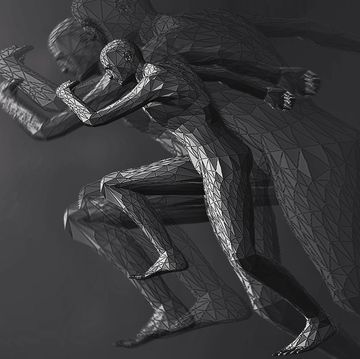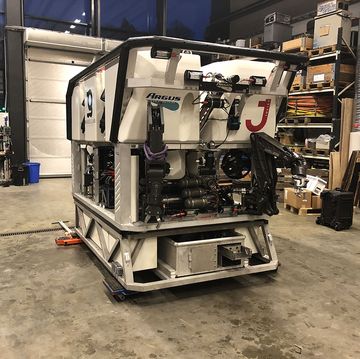It's called "porpoising"—the way dolphins swimming at high speeds leap out of the water because it avoids drag caused by swimming near the surface. Now scientists are learning to copy that trick.
This water-bound robot, built by Professor Junzhi Yu and colleagues at the Chinese Academy of Science in Beijing, is loosely modeled on a spotted dolphin, and the leaping is not just for show. It's a step toward mimicking this behavior for better underwater vehicles with the speed, efficiency, and agility of dolphins.
A dolphin's incredible speed has long fascinated researchers. In 1936 biologist James Gray calculated that it should be impossible for dolphins to swim at speeds of more than 20 mph because of underwater drag. Known as Gray's Paradox, this puzzle wasn't completely solved until 2014, when aptly named biologist Frank Fish showed that a dolphin's tail generates much more force than previously thought. Still, our understanding of the dynamics of dolphin swimming is still changing and growing, which is why this robot is so important.
Yu's robotic dolphin is designed with particular emphasis on streamlining as well as a high-thrust tail powered by electric motors, as described in a new paper out this month. The flukes (tail fins) and flippers are miniature versions of the real thing. At 29 inches long and ten pounds, the bot overall is about one-third the size of an adult spotted dolphin.
The main load-bearing parts of the skeleton are made of titanium, with other sections made of steel, aluminum, and nylon. The skin and flippers are polypropylene. The robot is completely self-contained, and a lithium-ion battery provides more than three hours of swimming time.
As for electronics, it's a mishmash of off-the-shelf components. Sensing is done with an "attitude heading reference system" built with miniature gyroscopes and accelerometers in the head. Meanwhile, a pressure sensor provides depth data. The whole thing is controlled with various commercial motor controllers and a central Cortex microcontroller.
Building the hardware was only part of the challenge. The other half was modeling and calculating the speeds and angles needed for recreating a dolphin's leap.
"The key challenge faced by the researchers in the fields of biomimetic dolphin robots is to accommodate daunting speed and control requirements of sideward and even vertical leaps," Yu told Popular Mechanics. "In this sense, I think, theoretical work and engineering equally share the importance to achieve the robot leaping."
The robot swims at 4.5 mph, or almost three body lengths per second, making it one of the fastest swimmers for its size ever built. More important from the design point of view is the "swimming number," created by measuring the distance traveled with each stroke of the tail. The robot has a swimming number of 0.61, which comes close the value for a real dolphin. This suggests that the designers have successfully captured the key elements needed for efficient high-speed swimming.
This robot will hopefully allow researchers to study dolphin locomotion without needing actual dolphins. After all, it's easier to attach instruments to a robot and have it go through a repeated series of exercises day after day. A real dolphin? Not so much. The robot can also be modified and its swimming parameters tweaked to understand factors like the length of each tail stroke.
With the dolphin's construction complete, the team now wants to investigate the robot's energy expenditure and the relationship between power and speed. This will hopefully improve the robo-dolphin's agility and leaping ability.
"Increasing jumping distance and height by improving mechanical design and control approaches is an ongoing endeavor," says Yu. "As the Olympic Motto goes, 'Faster, Higher, Stronger.'"















